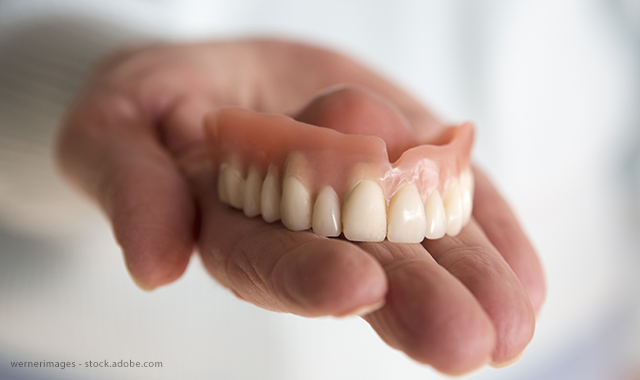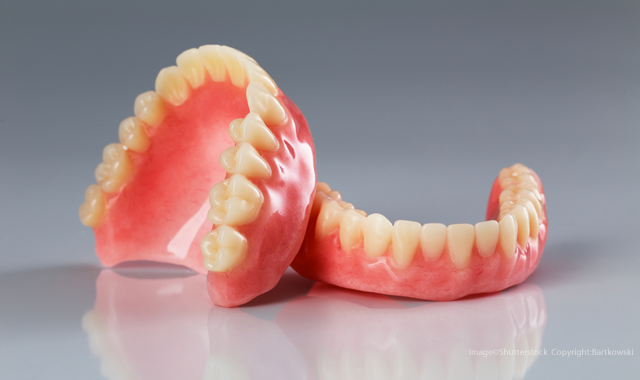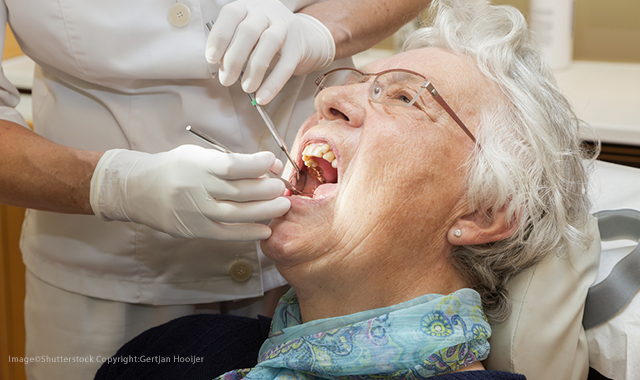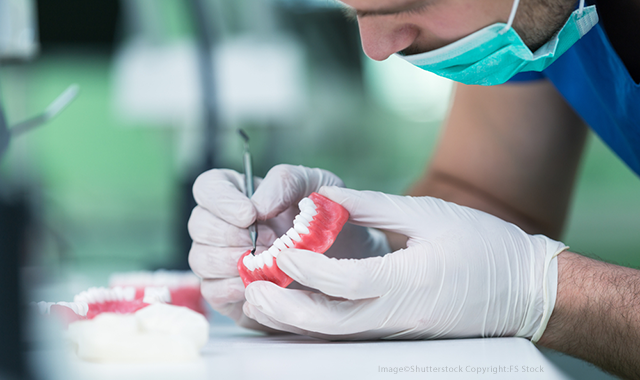4 tips for creating well-fitted dentures
Follow these best practices for creating dentures that are comfortable for patients to wear.
Dentures that don’t fit correctly are a significant patient complaint. Even worse, poorly fitting dentures can also lead to health problems down the road.

Dr. John Huebner, a general dentist in private practice in Lee’s Summit, Missouri, works with the denture patients at the practice. He says that getting an excellent fit is crucial and the methods for achieving a good fit is an area that hasn’t changed much over the past few decades.
Read more: How to use multifunctional teeth to create new dentures
Let’s look at the best practices for creating dentures that are comfortable for patients to wear.
Click through the slides to find out four tips for creating well-fitted dentures.


1. Get the right impression
“It all starts with good impressions and good materials for the impression,” Dr. Huebner says. “You still need a good custom tray or a well-adapted, pre-fabricated tray of some type to get the best impression, so you can capture all the anatomy that you need to get the best fit.”
Dr. Huebner notes that advances in the digital workflow will improve planning stages for some cases, particularly partials and implant-retained overdentures. However, the traditional complete denture still favors a custom tray or a customizable pre-fabricated tray and the two-impression system.
You can substitute for the custom tray a different tray made with a thermoplastic material, which can be cooled and heated several times without compromising its chemistry. If you’re trying to avoid a primary and a secondary impression, then you can also trim the tray if needed to make it work. However, Dr. Huebner thinks this method is still not as popular as taking a primary and a secondary impression with a custom tray.
More from the author: 3 major challenges when creating dentures
“A lot of people are not quite ready to get rid of their traditional two-impression system,” Dr. Huebner says.
Common mistakes clinicians make in their denture impressions are allowing slight inaccuracies or taking an insufficient final impression, where they capture most but not all of the anatomy. Dr. Huebner says to get the best fit, retention and stability, you have to get the final impression all the way to the borders.
“A lot of it goes back to your final impression, your border molding and traditional techniques for a complete denture,” Dr. Huebner says. You hate to have a case where you think you captured an adequate impression, and then you deliver it to the patient and it just doesn’t fit the way you want. You have to come back and reline it later. You think to yourself, ‘Shoot, if I would have retaken that final impression once, I could have saved myself headaches down the road.’"
For partials, and especially for patients who have many undercuts, Dr. Huebner recommends taking a digital impression instead of a traditional impression that might tear upon removal. The digital impression might help to avoid problems later.
Most of all, Dr. Huebner says to trust your instincts. Many times, when he’s unsure his impression was entirely adequate but moves forward with the denture in spite of it, he has problems with the fit. “Those are usually the ones that later on I say, ‘Oh! I was right in the first place,’” he says.
In addition to taking excellent impressions, Dr. Huebner encourages clinicians to maintain communication with the lab. He works with a few labs for his removable restorations. They do a lot of work behind the scenes, so communication is vital for a good fit.
“Being able to tell the lab when you think something is not quite right and vice versa is very important,” Dr. Huebner says.



2. Know what anatomy you can’t afford to miss
Dr. Tae Hyung Kim, chair of removable prosthodontics in the division of restorative science at the Herman Ostrow School of Dentistry of the University of Southern California, agrees that the impression is crucial to an excellent denture fit. However, he believes that many clinicians don’t know all the critical areas of the anatomy they need to capture.
“The primary reason they miss it is because they are not looking to capture it, they are not looking for it,” Dr. Kim says. “Quite amazingly, some practitioners do not even know if they missed it or not.”
Capturing two anatomical features in the maxillary impression is imperative for the denture to fit. The first is the Hamular Notch. The second is the distal buccal corner. Dr. Kim says students make fabulous dentures in the student clinic if they capture these parts of the patient’s anatomy, even if they haven’t made dentures before.
Trending article: 4 ways to improve your practice's infection control in 2019
Dr. Kim says if the impression captures the Hamular Notch, then the maxillary denture is almost guaranteed to fit.
“Any problem denture that we observe in the clinic, it’s highly likely this one is missing from the impression,” Dr. Kim says of the Hamular Notch.
The distal buccal corner is adjacent to the Hamular Notch, around the distal border. Dr. Kim says if you capture it in your impression, then the denture has no problem with retention. “If you don’t, or it’s shallow or there is leakage, you are looking for trouble,” he says.
Two critical areas of the anatomy affect the lower denture fit, Dr. Kim says. The first is the mid-lingual side, where the tongue is. Dr. Kim says if that area has a good seal, then the denture will function.
“If there is any leakage or air goes underneath that site, don’t expect any retention of the lower denture,” Dr. Kim explains.
The second critical area to capture for an excellent lower denture fit is the distal buccal corner, which used to be called the M-plane. Dr. Kim says it was called that because it’s the location of the master muscle and where the anatomy has proximity to the denture border.
“If that part is overextended, the denture will not stay, and it will move too much,” Dr. Kim explains. “If it is properly extended, the dentures stay in - and you can eat steak.”



3. Manage your patients’ great expectations
Per Dr. Huebner, another vital part of providing a great fit is managing patient expectations. Some patients don’t have a ton of surface area to work with, which affects how the denture feels.
Early and consistent communication about what to expect with a denture can alleviate some of the perceived problems after receiving it.
Related reading: How to create well-fitted, esthetic dentures using a simple digital workflow
“It drives you crazy sometimes. You have a patient come in, and they have had the same poor-fitting denture for 30 years, and they are happy with it and see no problems with it. Then, in another case, I’ll think I make the perfect denture. It fits, and it has great suction, and the person thinks they are going to be able to chew through a chain link fence,” Dr. Huebner says, “So, you have to manage the patient at the same time.”



4. Practice makes perfect
Dr. Kim says one of the problems with fit is the skill level of the clinician. Because the conventional way of manufacturing dentures is complicated, it’s too technically sensitive in the short term. The fit will depend on your skill level. “The quality of the denture will vary dramatically based on it,” Dr. Kim says.
Dr. Kim has dedicated his research to creating 3D removables, including partials and complete dentures. The dental students at USC have a curriculum on 3D printing for partial and full dentures - the first dental school to introduce it.
Removables produced with 3D technology are more accurate than traditionally produced dentures. The production itself is also more efficient than the conventional method; the doctor can deliver the dentures in only three visits versus five appointments the traditional way. They’re also more comfortable for the patient than conventional dentures.
More from the author: Digital impressions: Ready for their close-up?
“When it is made digitally, it means that technically, there is a lot less skill level sensitivity that will affect fit,” Dr. Kim says.
However, while the 3D technique is less technically demanding than the conventional method, there’s still a learning curve. The digital method is a new process with new habits. Dr. Kim compares it to riding a bike, and then an e-bike.
“When you are used to a bicycle, you know how to ride it. But if you have an e-bike, there is a learning curve. You think, ‘Oh, this is electrically motored. There is a slight difference,’” Dr. Kim explains. “Same thing on digital dentures. Digital impressions are different from traditional impressions. Once you learn how to make digital impressions, it’s a lot more consistent.”
